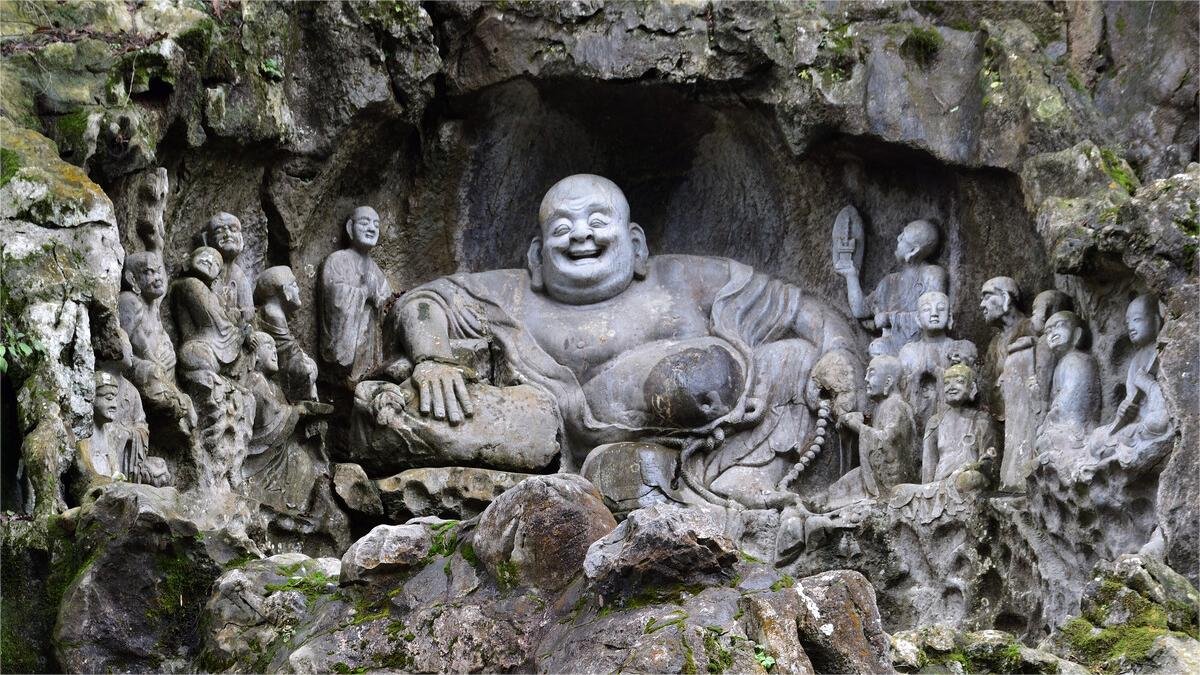Fei Lai Feng (飞来峰, Fei Lai Peak), also known as Peak that Flown Afar or Lingjiu Peak, is located next to the Lingyin Temple in Hangzhou, China. Soaring to a height of 168 meters, this peak is composed of limestone rock formations. Over time, the erosive forces of underground water have sculpted numerous fantastical and ever-changing caves and gorges on Fei Lai Feng, although many have been buried due to the passage of centuries.
The mountain is adorned with ancient trees and twisted vines that intricately weave through the landscape. However, what truly captivates visitors to Fei Lai Feng are the remarkably intact 345 Buddhist sculptures adorning the summit. These sculptures depict a diverse range of Buddhist themes, showcasing exquisite craftsmanship and a unique style. The detailed carvings bring the religious narratives to life, making it a captivating and wondrous spectacle. Fei Lai Feng stands as a marvel that rivals the renowned Dazu Rock Carvings in Chongqing, exemplifying the rich cultural and artistic heritage of the region.
Table of Contents
- Basic Information
- Location and Transportation
- Map of Fei Lai Peak
- Legends about Fei Lai Peak
- Stone Carvings in Fei Lai Feng
- Vlog about Fei Lai Feng
- Attractions near Fei Lai Feng
Basic Information
| Estimated Length of Tour | 0.5 – 1 hour |
| Ticket Price | 45 RMB |
| Opening Hours | 6.30 – 17.30 |
| Telephone Number | 0086-0571-87969691; 0086-0571-87973280; 0086-0571-87977767 |
Location and Transportation
Fei Lai Feng is situated in the Xihu (West Lake) District of Hangzhou, Zhejiang Province, China. The specific address is 1 Fayun Lane, Lingyin Road. To get there, tourists can take bus 103, 131, 324M, or 1314 and get off at Lingyin East Stop (灵隐东站).
Map of Fei Lai Peak

Legends about Fei Lai Peak
According to legend, there is a fascinating tale associated with Fei Lai Feng. The story goes that one day, the monk Jigong from Lingyin Temple had a sudden revelation that a mountain peak was about to fly in from a distance. At that time, there was a village in front of Lingyin Temple, and concerned for the safety of the villagers, Jigong rushed into the village urging everyone to leave. However, the villagers, accustomed to Jigong’s eccentric behavior and playful pranks, thought he was joking and paid no heed to his warnings.
As the peak seemed on the verge of arrival, Jigong, in desperation, entered a house where a wedding was taking place, swiftly picked up the bride in the midst of the ceremony, and fled. The villagers, witnessing the monk absconding with the bride, chased after him. Suddenly, a deafening sound echoed, the sky darkened, and with a tremendous crash, the mountain peak descended in front of Lingyin Temple, obliterating the entire village. It was then that the people realized Jigong had seized the bride to save them, leading to the mountain being named “Fei Lai Feng” or “Peak that Flown Afar.”
Another version of the legend traces its origin to over 1600 years ago when an Indian monk named Hui Li arrived in Hangzhou. Astonished by the sight of the peak, he exclaimed, “This is a small ridge from the Indian country’s Lingjiu Mountain. How did it fly here?” Hence, it became known as Fei Lai Feng, immortalizing the miraculous tales surrounding its arrival.
Stone Carvings in Fei Lai Feng

Fei Lai Feng is renowned for its impressive collection of stone carvings, with over 470 sculptures dating from the Five Dynasties to the Song and Yuan periods. Among them, 335 sculptures remain either fully intact or in relatively good condition. The earliest carvings, including images of Amitabha, Guanyin, and Mahasthamaprapta, were created in 951 AD and can be found at the entrance to Qinglin Cave, to the right.
The Song Dynasty contributed more than 200 sculptures, with a prevalence of seated figures. The bas-relief carving of the Lushena Buddha Assembly stands out as one of the most exquisite works from the Song era. Another notable sculpture is the large Maitreya Buddha from the Southern Song Dynasty, the largest of its kind at Fei Lai Feng and one of the earliest in China. Its cheerful and open countenance, exposed belly, and welcoming demeanor make it a favorite subject for visitors’ photographs.

Fei Lai Feng also features sculptures representing the Tibetan Buddhist tradition, particularly from the Yuan Dynasty. These carvings, numbering over 100, exhibit fine craftsmanship, delicate features, and a well-preserved condition. Notably, the carvings of Vajrasattva, Manjushri, and Samantabhadra on the outer wall of Qinglin Cave are the earliest Yuan Dynasty stone carvings in the West Lake area of Hangzhou.
In 1993, the Fei Lai Feng scenic area expanded to include the Zhonghua Stone Cave Art Convergence Garden. Leveraging the natural landscape of Fei Lai Feng and utilizing the advantages of stone carvings, this garden meticulously recreated stone carvings from various locations and time periods, including Chongqing Dazu Rock Carvings, Leshan Giant Buddha, Anyue Sleeping Buddha, Gansu Maijishan Grottoes, Shanxi Yungang Grottoes, and Henan Longmen Grottoes. Spanning 250 meters, the Convergence Garden showcases nearly ten thousand Buddha statues representing different regions and historical periods, creating a comprehensive and awe-inspiring display of China’s rich stone carving heritage.




